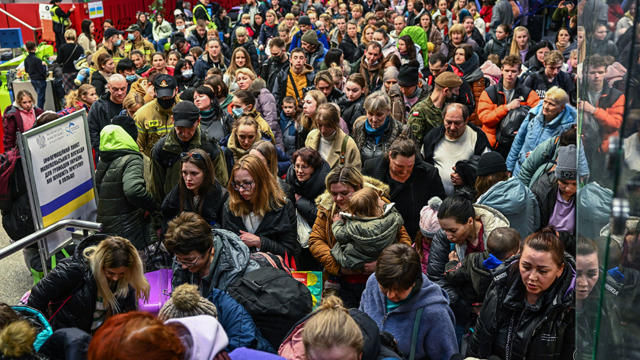
It is evident that both Russia and the US have done little to end the conflict in Ukraine. India has offered to join efforts to resolve the crisis amidst western concerns over an emerging Russia-China understanding on the road ahead. The US has rejected Chinese offers of mediation.
“It is evident that both Russia and the US have done little to end the conflict in Ukraine. India has offered to join efforts to resolve the conflict amidst western concerns over an emerging Russia-China understanding on the road ahead. The US has rejected Chinese offers of mediation. Moreover, Russia will not agree to any solution which involves it losing control of its vital and historical access to the sea in Crimea. There should also be restoration of peace and harmony between Russians and Ukrainians living in southern Ukraine. It would be helpful if access to the port city of Odessa remains open for use internationally.”

Following years of inept and confused leadership by the then President Mikhail Gorbachev, the Soviet Union fell apart, resulting in its former constituent republics attaining full independence on December 26, 1991. An interesting aspect of this collapse was that large numbers of Russians continued living in virtually all erstwhile Soviet republics. Thousands of Russians still remain in their old homes, and the Russian language remains widely spoken in virtually every former Soviet republic.
Erstwhile Soviet republics have, however, enhanced cooperation with other neighbors. Interestingly, the predominantly Muslim ones – Kazakhstan, Kyrgyzstan, Tajikistan and Uzbekistan – are members of the Shanghai Cooperation Organisation, while Azerbaijan is a dialogue partner. Historical ties with Russia, even today, play an important role across Central Asia. Russia’s western neighbors generally see greater benefit of cooperation with prosperous countries of western Europe, ranging from France and Germany to Norway, Sweden and Finland.
Russia has no reason to object to the Soviet Union’s former European Republics (on its northern and western borders) seeking closer ties with their European neighbors, including France and Germany. Its genuine concerns arise when these neighbors enter into military alliances with the US and NATO. The principal aim of the US role in NATO is perceived as being aimed at ‘surrounding and containing’ Russia.
The recent escalation of tensions in Europe has arisen from the sudden regard and affection of US President Joe Biden for the leadership of the young and relatively inexperienced Ukrainian President Volodymyr Zelenskyy. What has, thereby, emerged in recent years has been Ukraine’s growing security ties with the US. This has resulted in Ukraine being provided sophisticated weapons intended to give Kyiv the capabilities to challenge Russian land and maritime security interests, and pursue its own territorial ambitions on its southern shores.
The main territorial dispute between Russia and Ukraine over the Crimean Peninsula continues. Crimea has been ruled by the Russian Black Sea Fleet since 1783. It has, thus, historically been under Russian, and not Ukrainian sovereignty, for well over two centuries now. Moreover, while Russia has sought unfettered access to the port of Odessa, it has not succeeded in this effort. But, it would be sensible if Black Sea ports are used by both countries, which do ultimately share an interest in maritime trade.
This is particularly important for crucial wheat supplies from Ukraine and Russia to West Asia and Africa. Odessa has also been, for long, the most well-located port for India’s trade with both Ukraine and Russia. Any peace solution would naturally have to bear in mind the reality that under no circumstances will Russia agree to compromise its crucial national interests in Crimea. Moscow also has a natural interest in strengthening its historical access to the Black Sea port of Odessa.
Tensions between Ukraine and Russia flared up when Zelenskyy was elected President of Ukraine in 2019. Zelenskyy believed that he could assert his independence from Russia through close ties with the Biden administration. During his visit to Washington in 2021, he signed a joint declaration with President Biden; it was laced with strong anti-Russian rhetoric. The joint declaration said: “Unwavering commitment to Ukraine’s sovereignty, independence and territorial integrity within its internationally recognized borders, including Crimea, and extending to its territorial waters in the face of Russian aggression.” This was an assurance of support to Ukraine for actions which would undermine Russia’s access to the sea in Crimea. This was accompanied by rapid transfer of sophisticated US military hardware to Ukraine.
Russian President Vladimir Putin ordered his troops into southern Ukraine in February 2022 with the evident objective of seizing the cities of Luhansk and Donetsk by declaring them independent states. He, thereby, established Russia’s control over areas where the Russians are well positioned.
There are an estimated 7.7 million Russians in Ukraine, which has a total population of 43.3 million. The Russian population resides predominantly in six southern areas of Ukraine which control Russia’s access to the sea in Crimea. The Russian Black Sea Fleet has historically been Russia’s gateway to the Black Sea, the Sea of Azov and the Mediterranean Sea.
The poorly planned Russian military response that followed the Biden-Zelenskyy declaration, combined with massive US and NATO arms assistance to Ukraine, has threatened the historical and only Russian access to its southern seas. Russia had expected that it would rapidly take over large tracts of Ukraine, especially in Russian-dominated parts of southern Ukraine — from Crimea to Odessa. Fierce Ukrainian resistance, bolstered by arms support from the US and its NATO allies, blocked Russia’s moves westwards. More importantly, Russian positions in southern Ukraine remain under constant attack.
Over 14 million Ukrainians have been displaced so far, with seven million now in neighboring countries. Casualties on both sides are estimated at around 3,00,000 killed or wounded. Worse still, there is substantial reason to believe the allegations, reinforced by writings of veteran American investigative journalist Seymour Hersh, that in September 2022, the Biden administration destroyed two undersea oil pipelines carrying Russian gas. This was a gross violation of the international law that requires a thorough investigation.
It is evident that both Russia and the US have done little to end the conflict in Ukraine. India has offered to join efforts to resolve the conflict amidst western concerns over an emerging Russia-China understanding on the road ahead. The US has rejected Chinese offers of mediation. Moreover, Russia will not agree to any solution which involves it losing control of its vital and historical access to the sea in Crimea. There should also be restoration of peace and harmony between Russians and Ukrainians living in southern Ukraine. It would be helpful if access to the port city of Odessa remains open for use internationally.
(The author is Chancellor, Jammu Central University & India’s former High Commissioner to Pakistan)




Be the first to comment